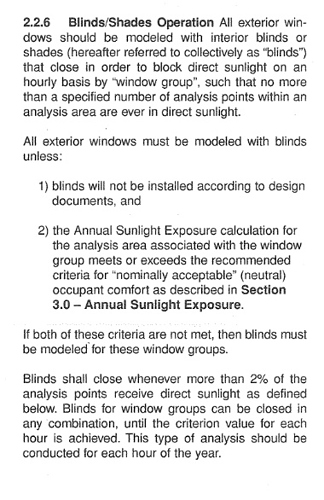@Mathiassn and @MingboPeng,
I read both links and reviewed the IES LM-83-12 document. Thank you both for sharing your thoughts and resources.
We can automate the process of generating blind states with what we currently have implemented in Honeybee[+] however there a couple of design decisions to be made. There is also a concern about the Grasshopper performance when the number of analysis points starts to be more than a couple of 1000, and the number of window groups are more than a couple of dozen.
Honeybee[+] calculates the direct contribution of sun separately from the diffuse sky which means there is no limitations for calculating the times when more than %2 of analysis points in each grid receive more than 1000 lux from direct sun. The question is how to calculate the blind combinations effectively.
Currently you can input/design the blind states when creating the case using window groups and blind states but I’m thinking to add another scenario which let you test the scenarios of desired dynamic blinds and study what will happen if you block a certain % of direct and sky/diffuse contribution. It seems to be more inline with what IES LM-83-12 section 2.2.7 describes:
“If BSDF data cannot be used, and the windows have fabric shades or curtains, model the shades using
a combination of specular and diffuse transmittance. The specular transmittance should be equal
to the openness factor of the fabric, while the diffuse transmittance should be the total visible light
transmission (VLT) minus the openness factor. If the VLT is known and the openness factor is not known,
model the VLT as diffuse transmittance only. If the shade VLT is unknown, model the shade using 5%
diffuse VLT with no specular transmittance.”
“If BSDF data cannot be used, and the windows have white louver blinds (>80% reflectance); use a 20%
VLT diffuse distribution for both sunlight and skylight. The VLT of darker blind colors shall be depreciated
proportionally, to a lower limit of i 0% diffuse VLT for black blinds (reflectance of 0%) for both sunlight and
skylight. Thus, blinds with 40% reflectance should be modeled at 15% VLT, while 60% reflectance should be set at 17.5% VLT, etc.”
Finally for addressing the possible performance issues for loading data, and several other reasons, we will be pushing the data from the analysis to a database which will make these calculations possible efficiently.
Let me know your thoughts and if this satisfies what you’re trying to achieve.

